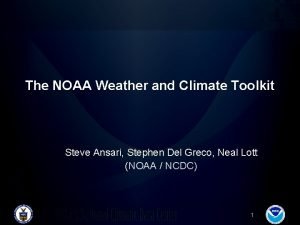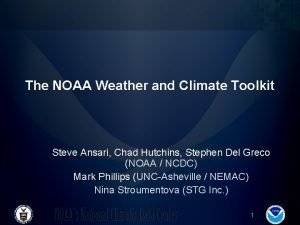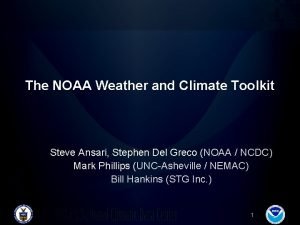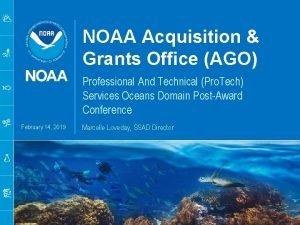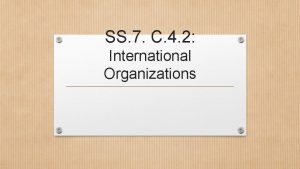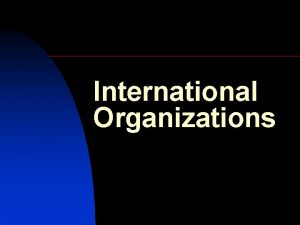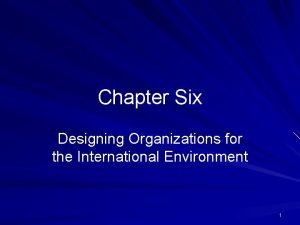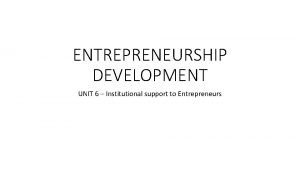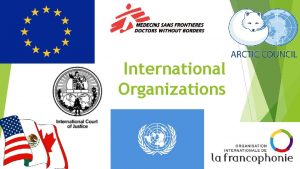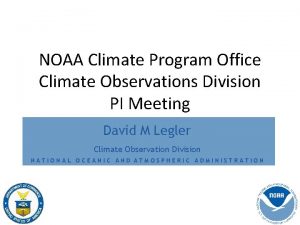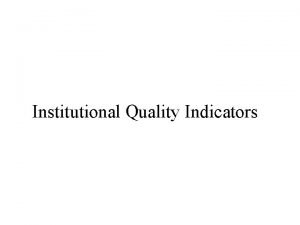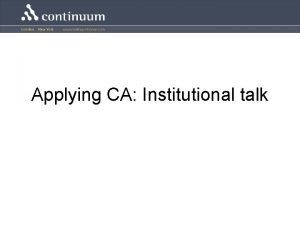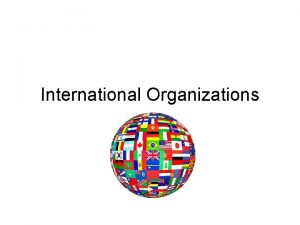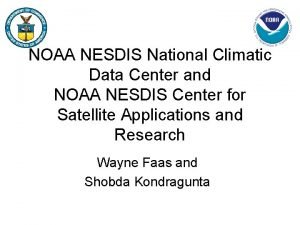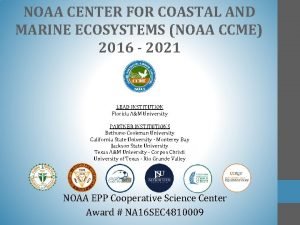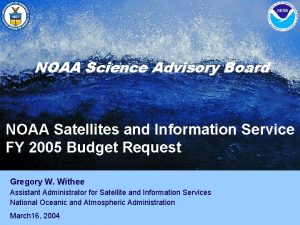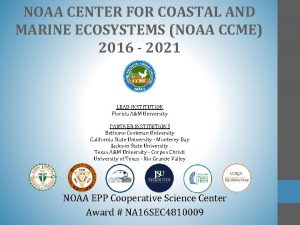Institutional and International Organizations NOAA Office of Climate




















- Slides: 20

Institutional and International Organizations NOAA Office of Climate Observation Report to PIRATA-12 Miami, USA 1 -3 November 2006 Mike Johnson Director, NOAA Office of Climate Observation photo courtesy of Meteo. France

Office of Climate Observation Mission Build and sustain a global climate observing system that will respond to the long-term observational requirements of the operational forecast centers, international research programs, and major scientific assessments. *Focus on the in situ Ocean component.

Climate Requirements • Document long term trends in sea level change • Document ocean carbon sources and sinks • Document the ocean’s storage and global transport of heat and fresh water • Document the ocean-atmosphere exchange of heat and fresh water

International Partnerships are Central A global system by definition crosses international boundaries. NOAA’s contributions are managed in cooperation with the Joint WMO/IOC Technical Commission for Oceanography and Marine Meteorology (JCOMM) -- presently 66 nations.

The Plan is in place Observations Programme Area Same Goals and Priorities OCO U. S. IOOS Global Component Implement the ocean domain of GCOS-92: • International GOOS • US IOOS Global Component • GEOSS Ocean Baseline • UNFCCC Priority • G 8 Commitment

GCOS-92 Implementation Targets are designed for climate but also serve global weather prediction, global and coastal ocean prediction, marine transportation, marine hazards warning, marine environmental monitoring, and many other non-climate users. • • Tide gauge stations Drifting Buoys Tropical Moored Buoys Profiling Floats Ships of Opportunity Ocean Reference Stations Ocean Carbon Networks • • • Arctic Observing System Dedicated Ship Support Data & Assimilation Subsystems Management and Product Delivery Satellites -- SST, Surface Topography, Wind, Color, Sea Ice

The organizing framework is in place All six global (in situ) implementation programs are now linked internationally through WMO/IOC JCOMM coordination

Initial Global Ocean Observing System for Climate Status against the GCOS Implementation Plan and JCOMM targets Total in situ networks 56% October 2006 57% 100% 42% 81% 21% 48% 66% 43% • A total of 5635 platforms are maintained globally. • Of these, 2591 are sponsored by OCO.

Progress and Priorities

PIRATA continues to be a Top Priority for OCO Tropical Moored Buoys PIRATA extensions and Indian Ocean Array

Surface Drifting Buoys 1250 sustained array (achieved) Users Workshop (March 2006) • Implement hourly reporting • Need barometers on all drifters (presently 385)

Pressure vs. Distance from Center of Rita New Addition to the western Tropical Atlantic: 30 Hurricane Drifters per year Drifting Buoys Deployed in Hurricane Rita 20 buoys measure air pressure, SST, wind speed & direction 8 buoys measure upper ocean temperature Wind Direction Data on Plot of Drifter Location Relative to Rita Center Forecast Track Courtesy of Scuba (2006) NOAA Hurricane Drifters ready for air deployment by the Hurricane Hunter Squadron at Keesler AFB

Argo Profiling Float Array 2527 active floats -- will reach 3000 by early 2007

PX 38 2 9 PX 0 3 PX 1 PX 02 0 PX 3 PX 18 PX 21 IX 15 11 29 7 PX 1 AX 15 AX 08 PX 50 PX 34 AX 20 AX PX 81 PX 06 PX 1 1 IX 2 2 1 IX 0 S IX 06 31 PX 04 PX 05 IX 08 09 IX IX 07 AX 34 PX 10 PX IX 10 AX 07 AX 4 AX 10 PX 37 PX 40 PX 4 AX 03 AX 18 AX 25 IX 28 PX 36 Well sampled Over sampled Partially sampled Under sampled Not sampled HDX Not sampled FRX AX 22 Note : AX 08 is Under sampled in FRX Mode SOOP: 39 of 51 lines now occupied

GCOS Climate Reference Network of Tide Gauge Stations By the end of 2007 most of the 170 Climate Reference Tide Gauge Stations Will Provide Marine Hazards Warning in Real Time

Measuring Ocean Carbon Sources and Sinks New carbon systems on NDBC Coastal Weather Buoys 1. Inventory 10 -year survey 2. Ships of opportunity 3. Moored buoy time series 38% complete

NOAA Contributions Future NOAA Deploying and maintaining 89 Ocean Reference Stations (42 now in service)

PIRATA • PIRATA Backbone • Brazil SW Extension • USA NE Extension • NDBC Hurricane systems • NTAS Climate Reference Station • Africa SE Extension

Tropical Moored Buoy Array • Transition of Pacific TAO operations from PMEL to NDBC is underway. • Indian Ocean expansion is underway - PMEL. • Enhancing Ocean Reference Stations in the Tropical Oceans is underway - PMEL • PIRATA: – Budget: • • 2004 -- $ 600 K 2005 -- $1035 K 2006 -- $1387 K 2007 -- $1387 K – Transition of operations from PMEL & AOML to NDBC ? • Need a “Program Plan” to ensure transition funding. • Next programming cycle would be 2010. • NDBC may begin serving real-time data “out of hide. ”

Thank You
 Weather and climate toolkit
Weather and climate toolkit Noaa wct
Noaa wct Noaa wct
Noaa wct Noaa nesdis org chart
Noaa nesdis org chart Ucf office of institutional equity
Ucf office of institutional equity Climate change 2014 mitigation of climate change
Climate change 2014 mitigation of climate change Guided notes international organizations
Guided notes international organizations International child welfare organizations
International child welfare organizations Universal international organizations
Universal international organizations International union of forest research organizations
International union of forest research organizations Universal international organizations
Universal international organizations Safrns
Safrns Designing organization for international environment
Designing organization for international environment Designing organizations for the international environment
Designing organizations for the international environment Universal international organizations
Universal international organizations Fairtrade labelling organizations international flo
Fairtrade labelling organizations international flo Onoxio
Onoxio Weatherbonk
Weatherbonk Factory office layout
Factory office layout Role of sisi in entrepreneurship development
Role of sisi in entrepreneurship development Roles and importance of institutional investors
Roles and importance of institutional investors
